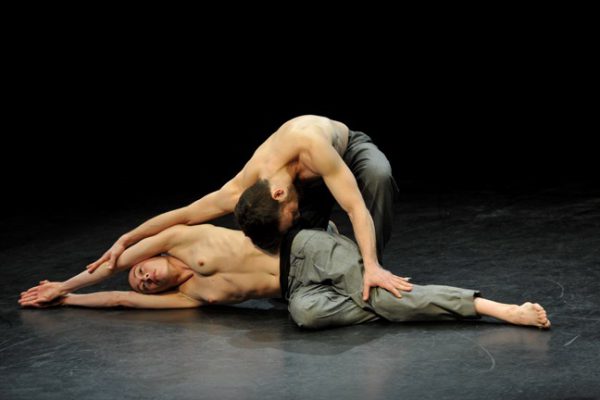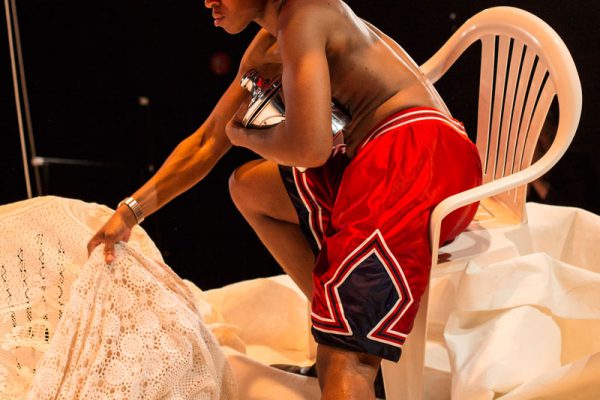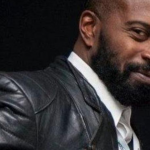In a fast-moving world, stillness is often presented as antithetical. To appreciate Akram Khan, the exalted British dance artist, is to see his fierce spins, angled gestures, intricate patterns and the sublime articulation of hands, fingers and feet. But it also means seeing his moments of soft repose, which give pause. It’s not just the virtuosity of his practice that stuns; it’s also his ability to give the viewer an immersive groundedness, leading to a sense of astonishment. And while his dancing displays an enigmatic beauty, the key to the puzzle lies in the energy and inspiration he draws from his source material: life, death and our search for humanity are key elements of XENOS, his newest work, now on tour in North America.
Xenos is the Greek word for foreigner or stranger. For this sixty-five-minute solo performance, Khan and his creative team started with the idea of the mythic figure Prometheus but evolved the production into the story of an Indian solider fighting in the First World War. In fact, the work was made as a UK arts commission in commemoration of the First World War centenary and evolves ideas of strangeness and estrangement within the context of that cataclysmic battle. The work also recuperates one aspect that time has obscured by telling the story of Indian soldiers who fought shoulder to shoulder with their European and North American comrades, fighting a foreign battle in a colonial world. Khan portrays one of those nameless unknown soldiers fighting in the conflict.
It’s important to note that, though, while Khan is known for contemporary dance choreography, he was schooled in kathak, the northern-Indian classical dance form. Muslim invaders of India adopted this Hindu temple ritual in the tenth century, and their rulers were looking for forms of court entertainment that better corresponded with their more secular tastes. The name derives from kathakar, the traditional storytellers or bards who, taking from both the Hindu and Islamic narratives, recited the sagas of contemporary heroes and commented upon current events and recounted the lore of Hindu mythology. In the form, male solo artists danced, sang and narrated tales of the gods’ and goddesses’ exploits. While kathak is narrative, Khan has always been more influenced by the abstract aspect of the dance, adopting an intransigent contemporaneity that transforms the classical. Khan structures his work with a powerful energy, leading him to dance with, as he has previously revealed in public talks, “extreme speeds of chaos.”
As the public enters the theatre to take their seats, we see a red-hued, steep slope with a village scene at the bottom, where there’s a garden party. Hindustani singer Aditya Prakash offers Carnatic–styled vocal arrangements while musician BC Manjunath performs percussion and konnakol. The stage is spare, with chairs and table, cushions and string lights with bare bulbs, all reminiscent of Indian village life. A celebration is about to unfold. Eventually the audience settles in. A series of disconcerting blackouts and brownouts cut the magic of that simpler existence, funnelling this intimacy into disturbing new terrain.
Khan enters at stage right, pulling thick twisted cordage. He is wearing a white kurta, commanding our attention. But who is this man? And why is he so distant from this otherwise warm environment? He distractedly finds his way through the rhythms of his kathak sequences while the percussionist eggs him on, chiding him to get on with things and focus. As we watch him spin, there’s preciseness and an expectation that he will soar. But there’s a broken quality to the endless spirals. For the kathak dancer, transformation is linked to the transcendence of the soul, but this soul is shattered by a greater horror, mirroring the turmoil of the battlefield.
The dance is cut short, the kurta muddied and, with it, the entire essence of country life. All ties that bind us vanish as all the set pieces onstage are hoisted up and away, over the edge of the rampart, by previously unseen ropes. Scenographer Mirella Weingarten does a masterful job of evoking a traditional Indian rural setting and transforming the space, with its almost volcanic promontory, into an avid vision of war. What remains is a viscerally bleak, uninhabitable terrain, with colours shifting from ochre to a grey bleakness, to which this anguished, exploited soldier is bound.
A poetic section ensues where Khan’s anklet bells (ghungroos) unravel and become cords that literally fling him across the trenches then transform into artillery belts strapped to his chest. He grades the hill. Then blackness fills the space. Soil and stones now cover the slope. We hear a distant voice: “Do not think this is war. This is not war. It is the end of the world.” These words, by Canadian playwright Jordan Tannahill, are poetic renderings of the revolving cycles of human conflict. In a particularly trenchant moment, we hear a voice intone an echo of the past: “And then I was a father, I was a son, and then in another time, I was a daughter, and then a father again, and a mother, several times. In another time. In my time I was a lover, again, several times. And for long stretches, alone. I’ve been alone. I am alone. I’ve been a solider on earth. I am alone, and again I’ve killed, and been killed. And again I’ve killed. I am alone.”
All of Khan’s collaborators dig deeply to frame the piece. Musician and composer Vincenzo Lamagna’s original acoustic music score and electronic sound design is deeply expressive. There’s an array of sounds — barking dogs, a cacophony of dissonance, bombing shells, a bagpipe issuing a mournful elegy — all suggesting the destruction of war. Musicians appear, and disappear from on high, illuminated (by Michael Hulls) in a muted, eerie light. The vocals by Nina Harries (also on double bass), plus Clarice Rarity on violin and Tamar Osborn on baritone saxophone are all live, with extracts from Mozart, and a number of traditional compositions. After the show, a friend of mine commented on the way the musicians brought us into the universe of the piece, appearing and disappearing as though apparitions or a dimension of the human soul.
Khan’s soldier is not a Prometheus, forever bound to a rock, who defies the gods. The maxim “Where there is life, there is hope” seems pointless as we watch this solitary figure, coiled to a long rope, become a disfigured and war-damaged man. Although devoid of this hope, it’s unbearably moving to watch his mud-caked and dusty body, one of the writhing wounded, traversing the plateau, a speck on a deathly canvas, riven by war. Another memorable image from the evening was a large gramophone speaker set on the ridge that whispered, almost inaudibly, the names of Indian soldiers and shifted into a wartime searchlight.
Khan dances as a man pulled from a full, rich culture who is thrown into the trenches of the war. The sense of aloneness permeates this piece, and there’s a tangible sense of loss captured and then illuminated. It’s made all the more palpable by the knowledge that Khan, now forty-four and in this last performance as a dancer, is saying goodbye, in one sense. We hear a voice ask, “What is my end? Where do I end?” Those questions no doubt resonate for Khan, in an existential sense.
This intelligent work ends with thousands of pinecones tumbling down the hill. It’s a beguiling image delivered with captivating force. While I’m on board for that decision, I have to mention that XENOS offers a frustrating series of endings. Beyond this critique, the piece is, by virtue of its content and context, sparking conversations people might not have otherwise about those less heard and less seen. On Khan’s stage, art brings down the barriers of cultural difference, and he’s compelled to mingle art with life in the gathering place of the theatre. Even if we’re unable to fully comprehend the scale and the atrocities of the Great War, the message of this piece is unmistakable: never again war (also the eponymous title of the German artist Käthe Kollwitz’s famous 1924 drawing). We need more antiwar statements, prompting us to question how truth survives.
Tagged: Contemporary, International





